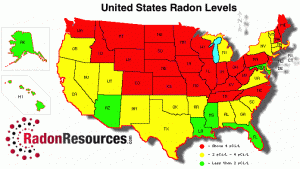As awareness grows, and knowledge on the deadly gas radon and its associated dangers become more widespread we’ll start to hear more and more about those who’ve had their lives affected by it. We’re willing to bet that there are quite a few folks out there who have been diagnosed with lung cancer, yet had no idea they were exposed to elevated levels of radon whether that be at home, work or somewhere else.
Prominent radon advocates are even having their own experiences with the deadly gas radon, after finding elevated levels in their own home. The manager of Spokane, Washington’s Air Quality Program is a perfect example of this scenario.
The Deadly Gas Radon Can Affect Anyone
 Twa-le Abrahamson-Swan already knew all about radon, which is an invisible, odorless and tasteless gas. As a frequent speaker about the dangers, she was even familiar with the fact that radon is the second leading cause of lung cancer in the United States, and the first in non-smokers. She also knows that more than 21,000 Americans die every year as a direct result of lung cancer, contracted from long term exposure to the deadly gas radon.
Twa-le Abrahamson-Swan already knew all about radon, which is an invisible, odorless and tasteless gas. As a frequent speaker about the dangers, she was even familiar with the fact that radon is the second leading cause of lung cancer in the United States, and the first in non-smokers. She also knows that more than 21,000 Americans die every year as a direct result of lung cancer, contracted from long term exposure to the deadly gas radon.
What she didn’t know is that the levels of the dangerous gas in her home were so high. She found out when she tested her home for the presence of the deadly gas radon, something she was doing to become familiar with the process itself. What she discovered is that the levels in her home ranged from 33 pCi/L to 53 pCi/L.
For reference, the recommended action limit as set by the EPA is 4.0 pCi/L. As you can see, the levels in Swan’s home far exceeded that limit.
Knowing this, Swan wrote to the US House of Representatives requesting additional funding to further boost radon awareness.
“I don’t smoke; neither do my kids, but our risk for lung cancer is the same as each of us smoking 106 cigarettes, or five packs per day.”
Testing Your Home for the Deadly Gas Radon Is Important
Radon is difficult to detect. In fact, the only way to discover its presence is to test specifically for it. Perhaps, that’s why most people go their entire lives without ever knowing it exists. The sad part about that is there are no short term symptoms, which means most who are affected won’t even find out there’s a problem until it’s too late.
That’s exactly why you need to test your home for radon. Test it now, while you and your family are still in good health. If – god forbid – you are not in good health, it’s still a good idea to test your home to prevent any further problems.
If you’d like more information on testing your home, what to do in the event you discover elevated levels or radon gas in general you can head on over to our resources section.


